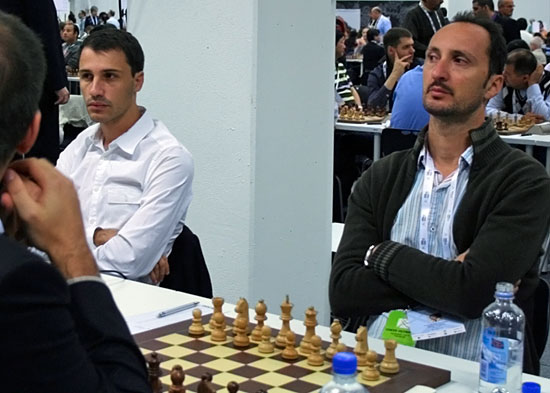
Marin on Tromso – round three selection
One of the main problems of modern opening preparation is how to break Black's walls in a series of fashionable hyper-solid lines. At first sight, this may seem to be a perennial problem, but things have not always been like this. Fashion and general approach change with the alternation of generations. In the best years of Tal and Kasparov, for instance, one common question was how to avoid being smashed tactically in the King's Indian! Moreover, some of Black's most reliable openings of today enjoyed a rather questionable reputation in the past.
After the supposedly warming-up days, the third round scheduled matches between teams of similar strength already, which makes natural the emergence of solid variations. The good news for those believing in the inexhaustible character of our favourite game is that in a few important games between strong players Black's walls did not stand White's pressure. The first game of the today's selection features what may be the main source for White's nightmares: the Berlin Defence. In the past, this was considered a modest variation, suited only for players wth good defensive skills in desperate need of a draw with black. Things have changed quite a lot over the past decades...

In the 2800+ club: GM Fabiano Caruana, board one for Italy

[Event "41st Olympiad Tromso 2014 Open"] [Site "Tromsø¸"] [Date "2014.08.04"] [Round "3"] [White "Caruana, Fabiano"] [Black "Negi, Parimarjan"] [Result "1-0"] [ECO "C67"] [WhiteElo "2801"] [BlackElo "2645"] [Annotator "Marin,Mihail"] [PlyCount "113"] [EventDate "2014.??.??"] [EventCountry "NOR"] [WhiteTeam "Italien"] [BlackTeam "Indien"] [WhiteTeamCountry "ITA"] [BlackTeamCountry "IND"] 1. e4 e5 2. Nf3 Nc6 3. Bb5 Nf6 4. O-O Nxe4 5. d4 Nd6 6. Bxc6 dxc6 7. dxe5 Nf5 8. Qxd8+ Kxd8 9. h3 {[#]} Bd7 {Actually, this is a questionable opening choice against the Italian super GM, who has obtained a few important victories against it.} ({Among other, he has caused Carlsen's only Berlin defeat in a game at classical time rate. It is interesting to mention that just as in the current game, Caruana met ...Bf8-e7 with g2-g4:} 9... h6 10. Rd1+ Ke8 11. Nc3 Bd7 12. Bf4 Rd8 13. Ne4 Be7 14. g4 {Caruana-Carlsen, Gashimov Memorial, Shamkir 2014}) 10. Rd1 Be7 {[#]} 11. g4 ({Earlier this year, Caruana had delayed the advance of the g-pawn for one move:} 11. Nc3 Kc8 12. g4 { Caruana-Adams, Dortmund 2014. White won after 48 moves. By playing g2-g4 one move earlier, White keeps the possibility of a different way of developing his remaining knight.}) 11... Nh4 12. Nxh4 Bxh4 {The knights' exchange has a few positive consequences for White. The f-pawn will be easier to advance while Black's chances for counterplay are reduced to the minimum.} 13. Nd2 $5 {This is where Caruana truly deviates from his game against Adams. The knight hurries to unblock the kingside and prepare the exchange of the dark-squared bishops.} Kc8 14. Nf3 Be7 15. Rd3 c5 {This is a thematic move, restricting the knight and preparing for ...Bc6.} ({However, it makes sense to prevent White's next move with} 15... h6 {as in Caruana-Grischuk, European team championship, Warsaw 2013.}) 16. Bg5 {It is worth mentioning that with the king on e7 this move would rather help Black who would get the e7-square for his king, with chances to attack the far advanced e5-pawn.} c4 $6 {With his development incomplete, Black should have abstained himself from displaying dynamic ambitions. Weakening the queenside dark squares will have a decisive influence in the final part of the game.} ({The cautious} 16... Re8 $5 {would have offered Black chances to get some counterplay against the e5-pawn.}) 17. Rd4 Bc6 18. Bxe7 Bxf3 {[#]Black must have overestimated the drawish tendencies of the rooks and opposite colured bishops ending. WHite can advance his massive kingside majority without having any kind of worries on the opposite side of the board.} 19. Kh2 Re8 20. Bh4 c6 21. Re1 Bd5 22. f4 a5 23. c3 b5 24. Rd2 b4 25. Bf2 bxc3 26. bxc3 Rb8 27. f5 a4 28. Bc5 {[#]All over this phase, we can notice the high mobility of the white bishop, a direct consequence of the impatient ...c5-c4.} Rb7 29. Kg3 Kd7 30. Ba3 Rb5 31. Kf4 Rbb8 32. h4 Rb5 33. h5 h6 {From practical point of view, it is very hard to decide which would be the best defensive structure. Black is doomed to passivity and can only hope not making things even worse for himself.} 34. Rdd1 f6 {Another committal decision. Black was probably worried of the threat f5-f6, but his move leaves the whole kingside weak transforming the e-pawn into a dangerous passer.} 35. e6+ Kc7 36. Rb1 Reb8 37. Rb4 Ra8 38. Reb1 Rab8 39. Ke3 Kb6 40. Rd1 Rxb4 41. Bxb4 Kc7 42. Re1 $1 {[#]An instructive Zugzwang position. Black's possibilities are strongly retsricted. He has to defend the b-file against the enemy rook's intrusion and the back rank against Bf8. This more or less imobilizes the king and rook, while the bishop has only one move at its disposal!} Kd8 {The alternatives are no better.} (42... Bg2 {exposes the bishop, allowing White to gain a decisive tempo in the following variation:} 43. Rb1 $1 {Threatening Bd6!+} Kc8 44. Rg1 $1 {Unpinning the bishop.} Bd5 45. Bf8 {With similar play as in the game.}) ({Or if} 42... Re8 43. Rb1 {the rook invades through the b-file since} Rb8 {is impossible due to} 44. Bd6+ $1) 43. Bf8 Rb7 44. e7+ Ke8 { [#]} 45. Re2 $5 {According to the classical standards, a technical move, preventing any econd rank counterplay.} ({But White's position was so strong that he could have done without it by playing} 45. Kf4 $5 {followed by Bxg7 soon.}) 45... Rb1 46. Bxg7 Kxe7 47. Kf2+ Kf7 48. Bxh6 a3 49. Bf4 Rd1 50. Bd6 { The start of the decisive attack.} Rd3 51. Re7+ Kg8 52. h6 Rh3 53. Rg7+ Kh8 54. Rg6 Rxc3 55. Be7 Kh7 56. Bxf6 {There is no defence against the mating attack based on g4-g5 and Rg7+.} Rc2+ {The last "revenge check".} 57. Kg3 1-0

Top Hungarian board: Peter Leko in round three

[Event "41st Olympiad Tromso 2014 Open"] [Site "Tromsø¸"] [Date "2014.08.04"] [Round "3"] [White "Leko, Peter"] [Black "Wang, Yue"] [Result "1-0"] [ECO "C42"] [WhiteElo "2740"] [BlackElo "2718"] [Annotator "Marin,Mihail"] [PlyCount "141"] [EventDate "2014.??.??"] [EventCountry "NOR"] [WhiteTeam "Ungarn"] [BlackTeam "China"] [WhiteTeamCountry "HUN"] [BlackTeamCountry "CHN"] 1. e4 e5 2. Nf3 Nf6 {Even though the Russian (Petroff) Defence has since always been regarded as a solid opening, its reputation as almost unbreakable started building up only in the late '90s, more or less at the same time with the rising of the Berlin defence. In the '70s and '80s the evaluation of the Petroff greately depended on which side of the board Karpov was sitting. He used to be merciless with white and unbeatable with black.} 3. Nxe5 d6 4. Nf3 Nxe4 5. Nc3 $5 ({Nowadays, there is not much White can hope for in the classical main line:} 5. d4 d5 6. Bd3) 5... Nxc3 6. dxc3 Be7 7. Be3 Nc6 8. Qd2 Be6 9. O-O-O Qd7 {[#]Despite his easy development and complete lack of weaknesses, Black tends to experience micro-problems in this line. Wherever he is going to castle, his king would be slightly mor eexposed than White's, while his minor pieces tend to be a bit vulnerable.} 10. h4 {Inhibiting Black's castling short.} h6 11. b3 {A new move.} ({The most popular continuation is} 11. Kb1) 11... Bf6 12. Nd4 $5 {A subtle move, causing unexpected problems.} a6 ({The natural sequence} 12... Nxd4 13. Bxd4 Bxd4 14. Qxd4 {practically forces} O-O {, yielding White good attacking chances after} 15. Bd3) 13. Nxe6 fxe6 {In view of his bishops' pair and the weakness on e6, White has emerged with a pleasant advantage out of the opening.} 14. g3 O-O-O 15. Bh3 Kb8 16. Rhe1 Rde8 17. Bg2 {Now or on the next move, White could have consider restricting Black's mobility with f2-f4. Leko might have feared a blockade based on ...h7-h5 followed by ...Ne7-f5, but due to the weakness of the e6-pawn that plan is not easy to carry out.} d5 18. Bc5 g5 19. hxg5 hxg5 { Over the past moves, Black has gained space on two important secotrs of the board and can now be happy with his position.} 20. Qe3 Qg7 {After almost half an hour of thought, Black decides to punish his opponent for weakening the c3-square in the early phase of the game. The game enters a concrete phase now. } 21. Bxd5 $5 {Quite a typical move for our main theme of today: breaking the walls.} exd5 $6 {Wang played this almost instantly, making clear that he had planned it in advance. He must have misevaluated something, since Black will get a slightly inferior ending in the best of the cases.} ({Analysing the consequences of} 21... Bxc3 22. Bxc6 {when the only move seems to be} Rd8 {is a bit beyond the frame of these express comments, so I kindly invite you to consult the next ChessBase Magazine.}) 22. Qxe8+ $1 Rxe8 23. Rxe8+ Bd8 24. Rxd5 Kc8 ({If} 24... b6 25. Rdxd8+ Nxd8 26. Rxd8+ Kb7 27. Bd4 {White's position would be rather pleasant. Strictly speaking, he would have a small material advantage already, with a safe king and chances for creating a passed pawn. However, I doubt that he could hope for a win against accurate defence.}) 25. Be7 {[#]} Qxe7 $2 {This leads to a very difficult, quite possibly lost, ending. } ({Black might have failed to notice that after} 25... b6 $5 26. Bxg5 Kb7 27. Bxd8 {he would have the resource} Qf7 $1 {attacking both rooks. The knight controls the only square on which rooks can be connected.} 28. Rde5 Nxe5 29. Rxe5 Qxf2 30. Bh4 {White's coordination is worse than in the previous line, so Black could count on a draw.}) 26. Rxe7 Bxe7 27. Kd2 {[#]With rook and two pawns against two minor pieces plus an active king White has every chance to win.} Bf6 28. Ke3 Ne7 29. Rd3 Nf5+ 30. Kf3 b5 31. Kg4 Nd6 32. Kh5 Kd7 33. Kg6 Be7 34. f4 gxf4 35. gxf4 Ke8 36. f5 Nf7 37. Re3 Kf8 38. f6 Bd6 {White has made a lot of progress, but for a long while Leko will not find a concrete plan, sticking to moving his rook around.} 39. Rh3 Kg8 40. Kf5 Kf8 41. Rh5 Ke8 42. Rh7 Bf8 43. Rh4 Kd7 44. Rh7 Ke8 45. Rh1 Bd6 46. Kg6 Kf8 47. Rh7 Ne5+ 48. Kf5 Nf7 49. Rg7 Nd8 {[#]} 50. c4 $1 {Finally something concrete. In principle, White will try question the stability of the black bishop with c4-c5, but that is not easy to achieve yet.} bxc4 51. bxc4 Nb7 $2 {Making things simple for White. It many times happens that Black has two knights and only one good square for them. Here we have the opposite: two blocking squares (f7 and c5) and only one knight.} ({He should have kept the pawn under control with} 51... Nf7 {, when White would have had to work a bit more to win.}) 52. Kg6 {With the imparable threat f6-f7.} Ke8 53. f7+ Kd8 54. Rg8+ Kd7 {[#]} 55. Ra8 { Playing cat and mouse a bit.} ({Black's counterplay would be easy to restrict after} 55. f8=Q Bxf8 56. Rxf8 Kc6 57. Rf5 Nd6 58. Ra5 Kb6 59. Ra4) 55... Nd8 56. Kg7 Ne6+ 57. Kg8 Nc5 {Allwoing White to create a second passed pawn would have been equally hopeless.} 58. f8=Q Bxf8 59. Kxf8 Kc6 60. Ke7 Kb6 61. Kf6 Kb7 62. Rh8 {Somewhere around this moment one gets the feeling that Black has missed the right moment for resigning. But this is typical for games deciding the final outcome of the match.} Nd7+ 63. Ke6 Nb6 64. c5 Na4 65. Kd5 Nc3+ 66. Kc4 Nb5 67. Rh6 Na7 68. Kd5 Nb5 69. Rh3 c6+ 70. Kc4 a5 71. Rb3 1-0
It may seem strange that I have put the Leningrad Dutch into the same category with the Berlin and the Petroff defences. The Dutch is highly non-symmetrical and has been traditionally considered a good weapon to play for a win by assuming high psoitional risks. However, over the past years White has systematically failed to prove an advantage in the main lines with g2-g3, so players like Kramnik and Aronian have started experimenting with rare and unexplored systems of developing. Besides, the description "wall" surely applies to the structure Black is aiming for, maybe to a higher extent than in the aforementioned openings. On basis of all these, I hope you will wellcome the Leningrad Dutch in the group of wall-defences.

Top boards for Bulgaria: Ivan Cheparinov (left) and Veselin Topalov

[Event "41st Olympiad Tromso 2014 Open"] [Site "Tromsø¸"] [Date "2014.08.04"] [Round "3"] [White "Topalov, Veselin"] [Black "Vallejo Pons, Francisco"] [Result "1-0"] [ECO "A85"] [WhiteElo "2772"] [BlackElo "2698"] [Annotator "Marin,Mihail"] [PlyCount "85"] [EventDate "2014.??.??"] [EventCountry "NOR"] [WhiteTeam "Bulgarien"] [BlackTeam "Spanien"] [WhiteTeamCountry "BUL"] [BlackTeamCountry "ESP"] 1. d4 f5 2. c4 Nf6 3. Nc3 {Topalov also deviates from the main lines.} e6 $5 { Not really switching to another system. The positional threat of ...Bb4 induces the next move after which Black will be ready to continue his Leningrad style development.} 4. a3 g6 5. Bf4 {Reminiscent of Aronian-Van Wely, Wijk aan Zee 2014.} Bg7 6. e3 O-O 7. Nf3 d6 8. Be2 {[#]At the moment, the move ...e7-e6 is more useful than a2-a3. It prevents a central blockade based on d4-d5 and allows the queen's development to e7.} h6 {This plan loses time and results into the weakening of the light squares. It is not necessarily bad, but it requires increased accuracy.} ({I would prefer} 8... Nc6 9. Qc2 Qe7 {, preparing either ...e6-e5 or ...Nd8-f7.}) 9. h3 g5 10. Bh2 Nbd7 ({The same plan as above does not work out so well now:} 10... Qe7 11. Qc2 Nc6 12. d5 Nd8 13. Bd3 {and f5 is hard to defend.}) 11. Qc2 b6 12. Rd1 Kh8 13. b4 Bb7 {[#]} 14. d5 $1 {After the bishop has emerged on b7, this is just natural, but Black has indirect ways of defending the f5-pawn.} e5 $1 15. Nd2 (15. Qxf5 $6 {does not work out well due to:} Nxd5 16. Qc2 Nxc3 17. Qxc3 e4 18. Nd4 c5) 15... c6 $6 {There was no need to weaken the d6-pawn so soon. True, the bishop is temporarily passive on b7, but could be recycled with a later ...Bb7-c8.} ({ The neutral} 15... a5 {is an important alternative.}) ({But I would mainly consider} 15... f4 {, removing the problems with the hanging pawn and giving the h2-bishop a hard time. The computer is quite skeptical about my idea, but engines tend to underestimate the importance of cutting such bishops off-play.} ) 16. dxc6 Bxc6 17. O-O Rc8 ({Due to the weaknesses along the d-file, it is too late for} 17... f4 18. Nde4 {already.}) 18. Qxf5 $1 {Just like in the game Leko-Wang, White destroys the wall with a positional queens sacrifice.} Ne4 19. Qxf8+ $1 Bxf8 20. Ndxe4 Qc7 21. Rd2 Kg7 22. Rfd1 {[#]As I mentioned on my Leningrad Dutch DVD, when things go wrong for Black in this opening, they can really spoil your day. Soon there will be only ruins left out of the black wall.} Nf6 23. Nxd6 Bxd6 24. Rxd6 Qe7 25. Bg3 Be8 {[#]} 26. Rxf6 $5 {Not really necessary, but strong enough and rather typical for Topalov.} Qxf6 27. Ne4 Qg6 28. Nd6 Ba4 29. Rd5 Qb1+ {The queen's activity is very sterile, since WHite dominates the centre and has no weaknesses.} 30. Kh2 Rf8 31. c5 Bb3 32. Rxe5 Qc2 33. Bf3 {[#]} Rxf3 {The bishops were getting too strong. However, this return sacrifice does not save the game.} 34. gxf3 bxc5 35. bxc5 Ba4 36. Nf5+ Kg6 37. c6 h5 38. Nd4 Qc4 39. h4 gxh4 40. Bxh4 a5 41. Re6+ Kf7 42. Re7+ Kg6 43. c7 1-0
About the author

GM Mihail Marin, born in 1965, has several times been Romanian champion and first made the leap over the Elo barrier of 2600 in 2001. Marin possesses a rare gift for a grandmaster – he is able to explain in readily comprehensible terms the ideas behind moves, variations and positions. This ability is there for all to admire in his contributions to ChessBase Magazine. Marin has written some books which have earned the highest of praise, among which are "Secrets of Chess Defence" and "Learn from the legends". Marin lives in Bucharest and is married to women's International Master Luiza Marin.
ChessBase DVDs by GM Mihail Marin

View all of GM Mihail Marin here
All you need to know about the Olympiad
- Full information on the games, the venue, the atmosphere and what's happening on and off the chessboard – 68 pages in PDF, 45 MB in size.
- All practical details you need to know before and after your arrival, including information about money, the climate, arriving at Oslo and Tromsø Airports, lost or delayed luggage, check-in at the hotels, the accreditation desk, information offices and the opening ceremony.
All ChessBase reports on the 2014 Olympiad in Tromsø






























